Opticon Sensors Europe PHL7100-BW Portable Data Terminal User Manual Manual Part 7
Opticon Sensors Europe BV Portable Data Terminal Manual Part 7
Contents
Manual Part 7
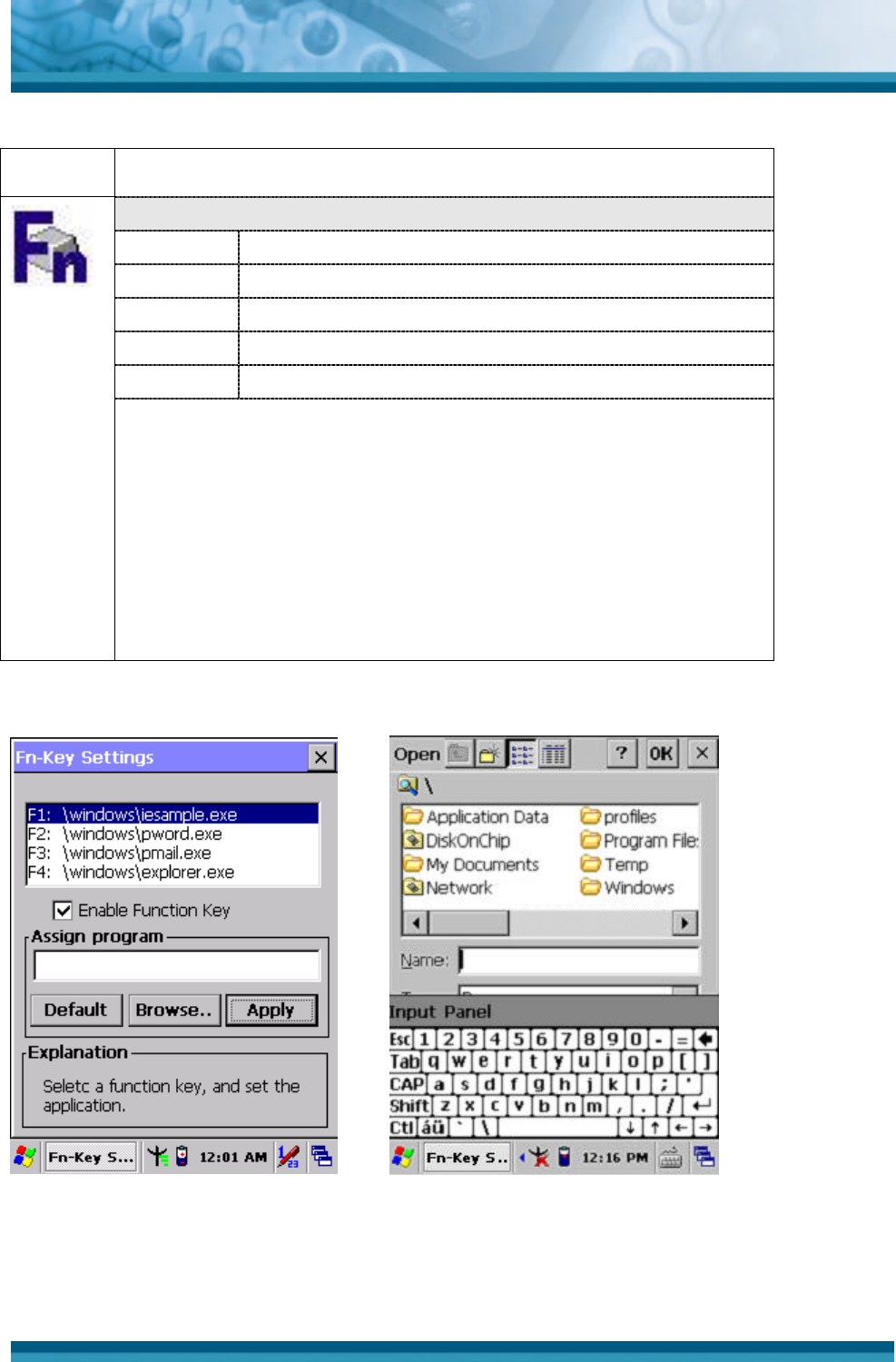
OPTICON
User's manual
PHL-7000 series
3
-
27
3.2.4.4 Fn-key Settings
ICON ITEM & FUNCTION
• Fn-Key Setting (Figure 3-42)
Fn Key The Application Program of default setting
F1 Internet Explorer
F2 Microsoft WordPad
F3 Inbox
F4 My Computer
ü To assign your favorite application program to F1, F2, F3 and
F4 hot keys.
ü Choose one of F1, F2, F3 and F4 from pull-down list.(Figure
3-43)
ü To tap “Browse…” inside “Assign program” applet.
ü Select one application program you want from program list,
then, choose “OK”. (Figure 3-43)
ü To tap “Default” to return back to default setting. (Figure 3-42)
Table 3-23 Fn-Key
Figure 3-42 Fn-Key Settings Figure 3-43 Fn-Key Settings
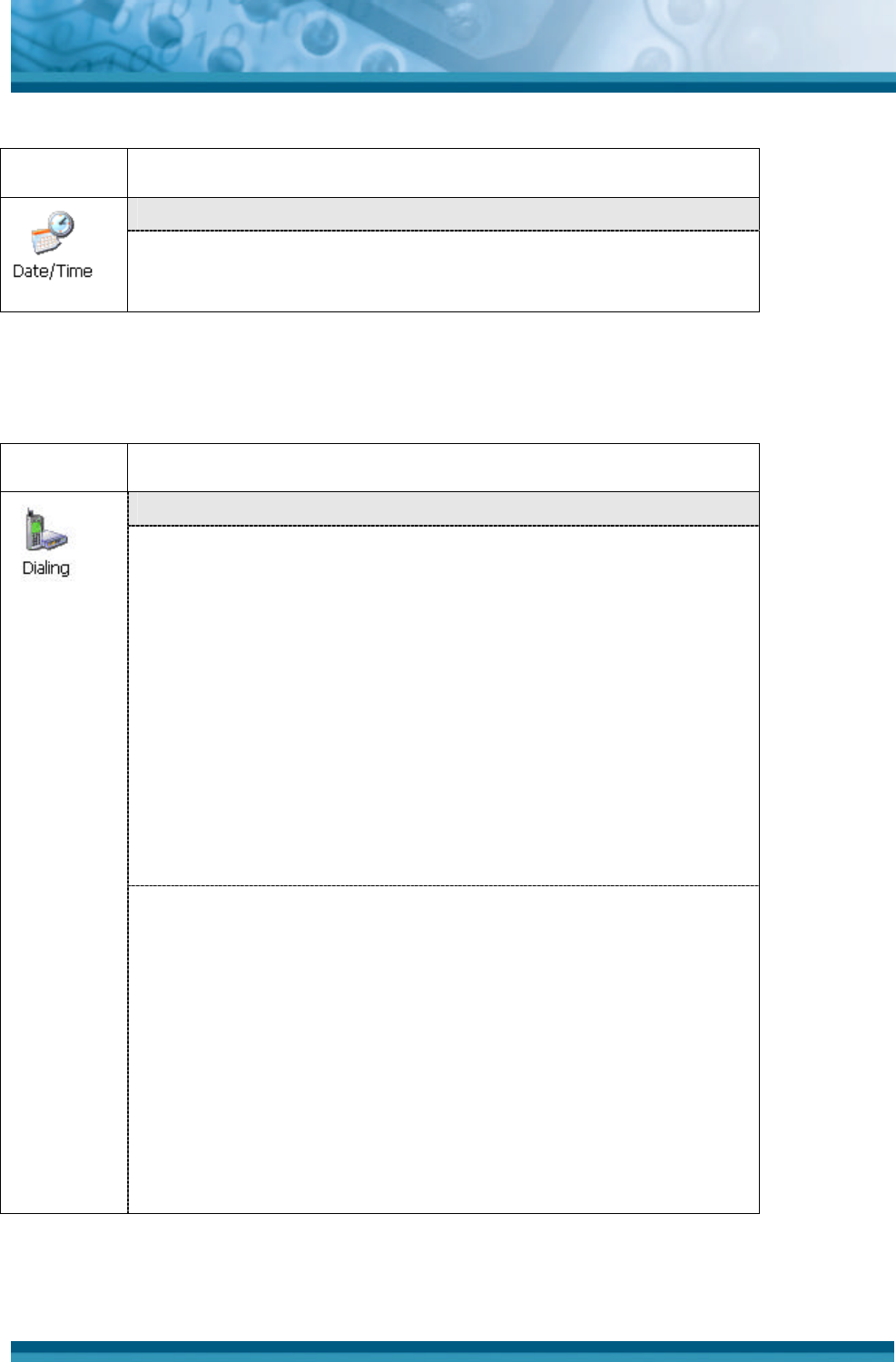
OPTICON
User's manual
PHL-7000 series
3
-
28
3.2.5 Date/Time
ICON ITEM & FUNCTION
• “Date/Time” Tab :( Figure 2-14)
ü Please see the detail information of 2.5.1 Setting Time
and Date
Table 3-25 Date/Time
3.2.6 Dialing Properties
ICON ITEM & FUNCTION
• “Dialing Properties” Tab :( Figure 3-44)
ü In the When dialing from list, select the “Location” where
you want to change settings.(Figure 3-45)
ü To create a new location, select “New”. Enter the name of
the location, and then select “OK”.(Figure 3-46)
ü Enter or edit the area code and local country code as
needed.
ü In Dial using, select “Tone dialing” or “Pulse dialing”.
Most phone lines are tone.
ü To automatically disable call waiting, select “Disable call
waiting by dialing”, select the appropriate number
sequence in the list, or enter a new sequence.
• Editing dialing patterns (Figure 3-47)
ü Using the codes listed in the topic; revise the dialing
patterns as needed.
Notes:
n If you need to use character other than the ones listed
here, use manual dialing.
n Hyphens and spaces in dialing strings are ignored.
n Some modems may not respond to the following
characters, even though your device lets you add them
to the dial string.
Table 3-26 Dialing properties
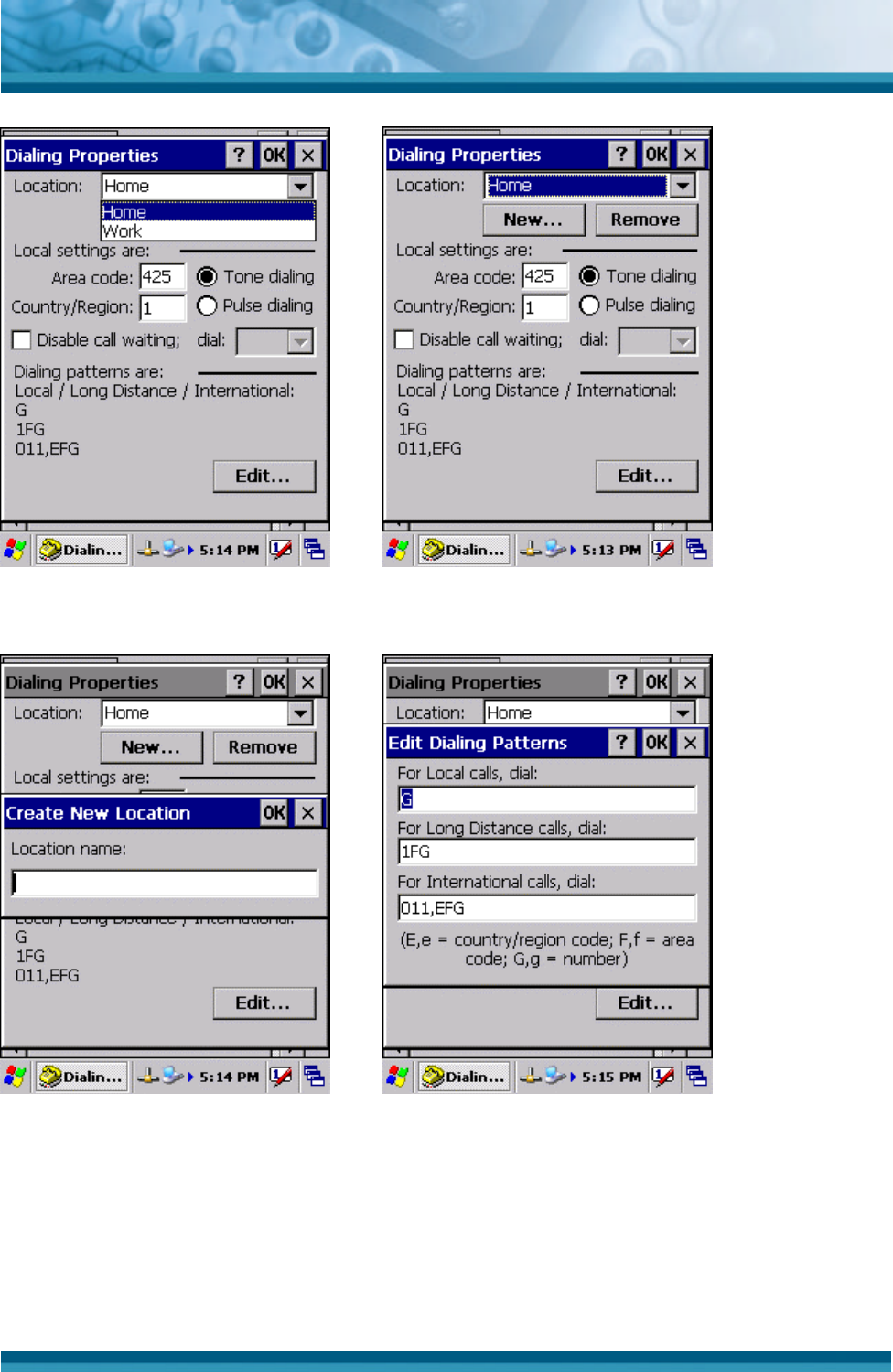
OPTICON
User's manual
PHL-7000 series
3
-
29
Figure 3-44 Dialing Properties Figure 3-45 Dialing Properties
Figure 3-46 Dialing Properties Figure 3-47 Dialing Properties
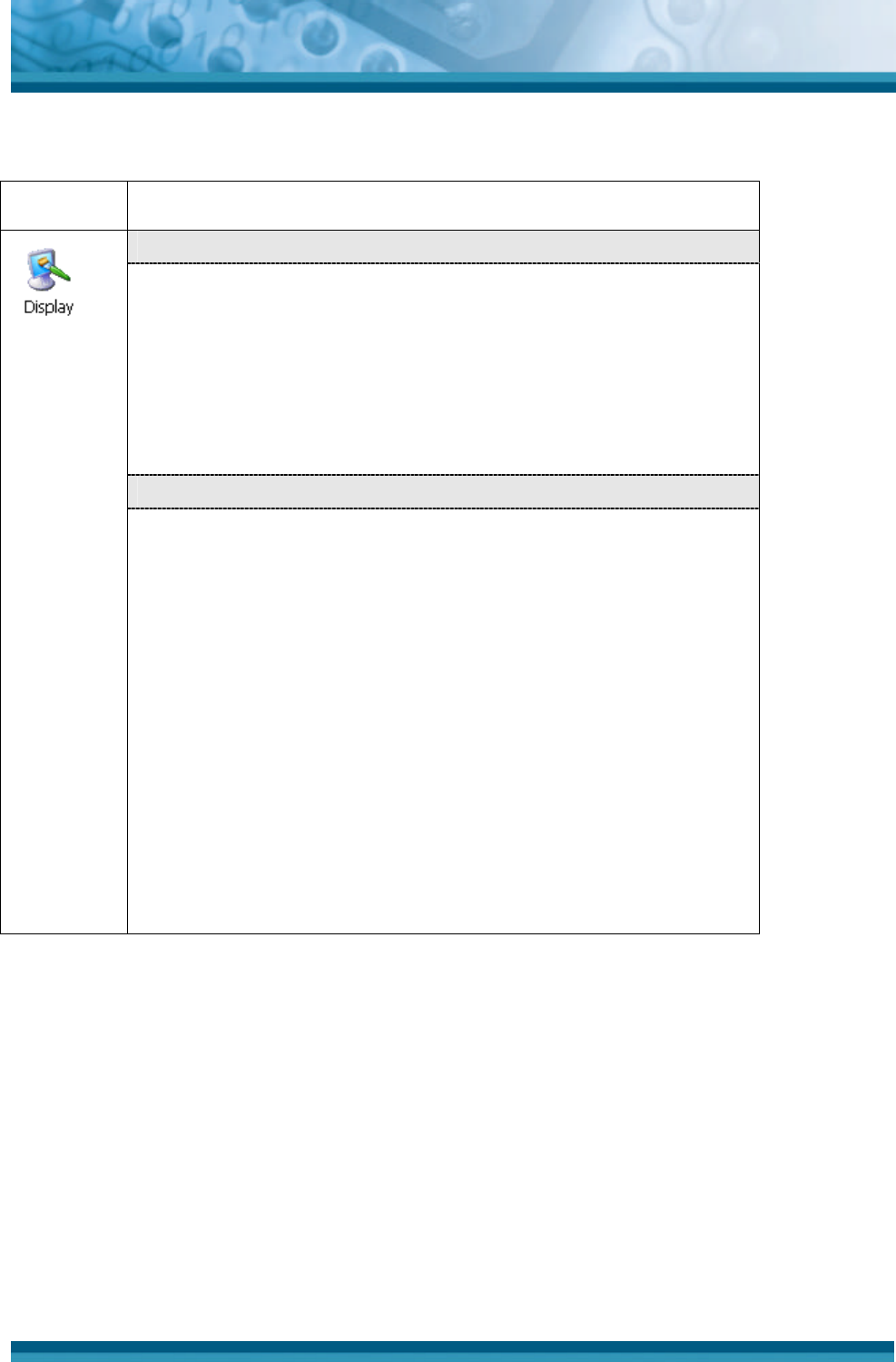
OPTICON
User's manual
PHL-7000 series
3
-
30
3.2.7 Display Properties
ICON ITEM & FUNCTION
• “Background” Tab :( Figure 3-48)
ü From the “Image” list, select an image you want as the
background of the desktop.(Figure 3-49)
ü To locate an image in another folder, select
“Browse”.(Figure 3-50)
ü To have the image cover the entire background, select “Tile
image on background”
• “Appearance” Tab(Figure 3-51)
ü Change the color scheme :( Figure 3-52)
Ø From the” Scheme” list, select a scheme.
Ø View your choice in the preview box. If you like the
scheme, select “Apply”.
ü Create a custom color scheme:
Ø From the “Item” list, select a display item.
Ø From the “Basic colors” list, select a color, and select
“OK”.
Ø View your color selection(s) in the Preview box.
Ø To save the scheme, select “Save”.
Ø In the “Save this color scheme as” box, enter a name
for the scheme, and select “OK”.
Ø Select “Apply”.
Table 3-27 Display properties
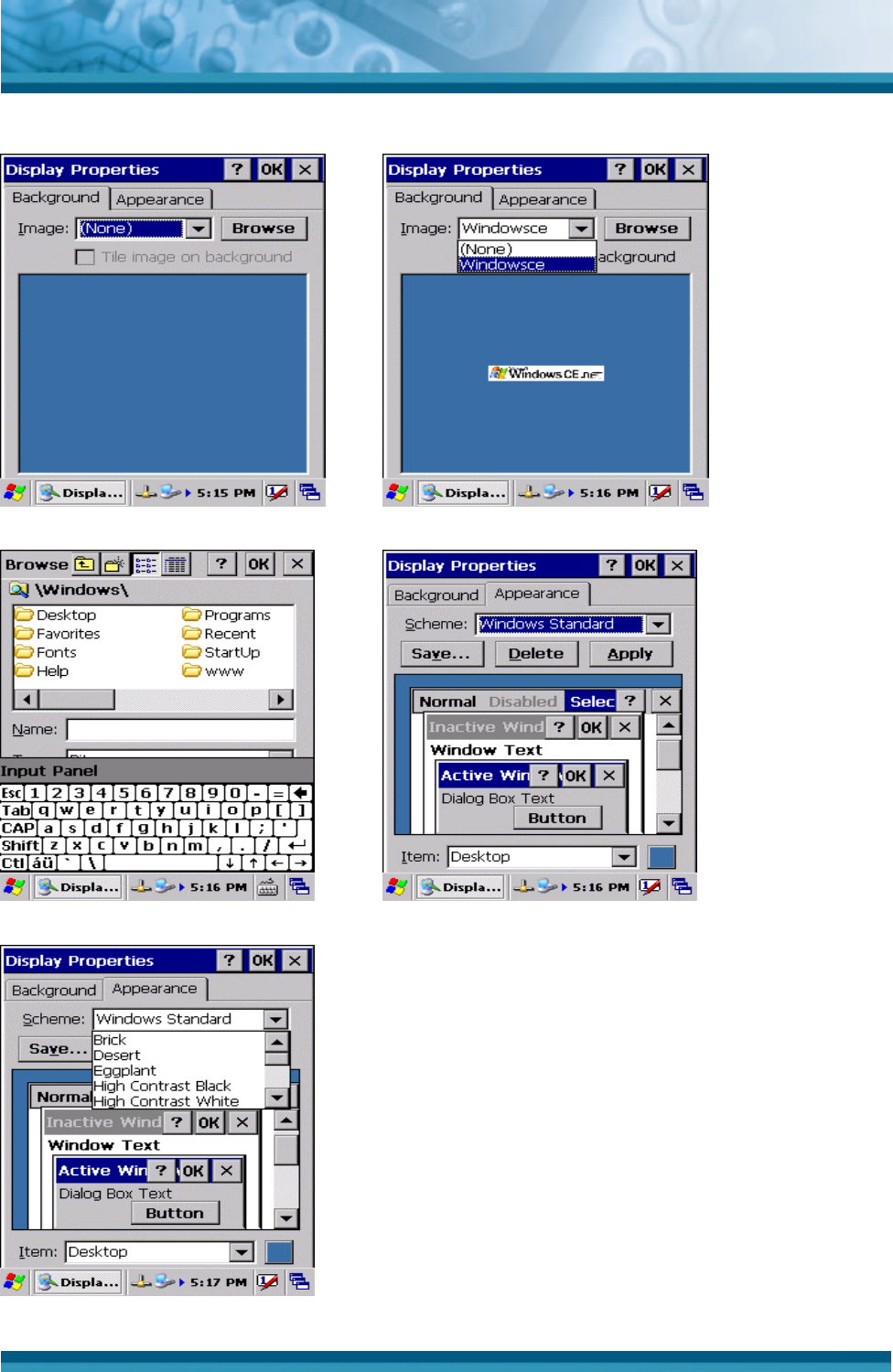
OPTICON
User's manual
PHL-7000 series
3
-
31
Figure 3-48 Display properties Figure 3-49 Display properties
Figure 3-50 Display properties Figure 3-51 Display properties
Figure 3-52 Display properties
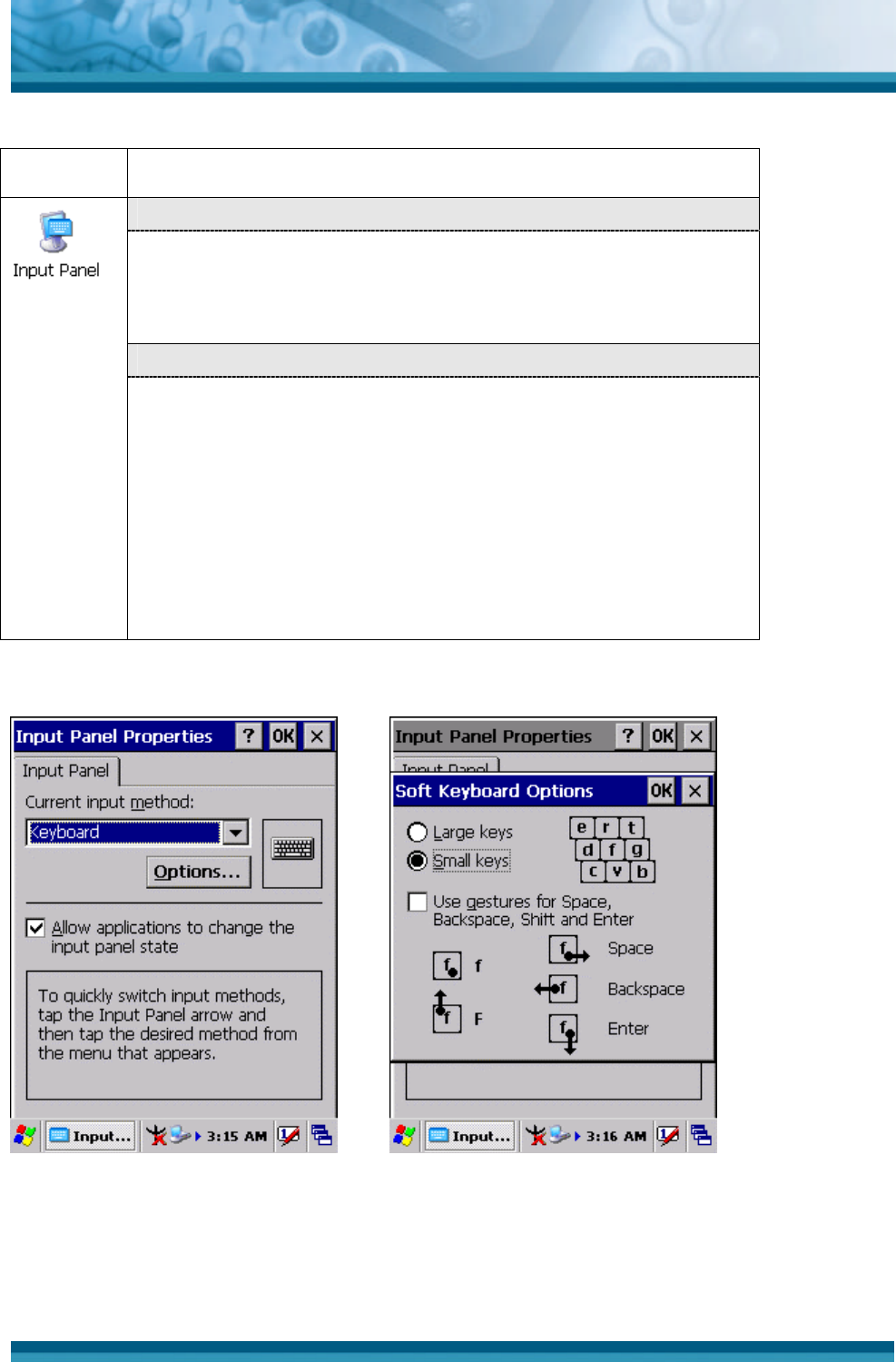
OPTICON
User's manual
PHL-7000 series
3
-
32
3.2.8 Input Panel
ICON ITEM & FUNCTION
• “Input panel” Tab :( Figure 3-53)
ü Select the input method you want to change.
ü To change the Soft Keyboard Options , tap “Option”
(Figure 3-54) .
• “Options” Tab :
ü Change the soft keyboard options as desired, selecting
from:
Ø Large or small keys
Ø Using gestures for space, black-space shift, and enter.
ü To exit the soft keyboard Options, press “OK” on the
control bar, or press the <Enter> key on the keypad.
ü To exit the Input Panel, press “OK” on the control bar, or
press the <Enter> key on the keypad.
Table 3-28 Display properties
Figure 3-53 Input Panel Properties Figure 3-54 Input Panel Properties

OPTICON
User's manual
PHL-7000 series
3
-
33
3.2.9 Internet Options
ICON ITEM & FUNCTION
• “General” Tab :( Figure 3-55)
ü Type in the URL of desired start page and the desired
search engine. You also change the Cache Size, clear the
Cache and Clear the History..
• “Connection” Tab :( Figure 3-56)
ü Modify the network access setting as desired.
• “Security” Tab (Figure 3-57)
ü Modify the security settings as desired. You can enable any
of the following by tapping the checkbox:
Ø Allow cookies
Ø Allow TLS 1.0 security
Ø Allow SSL 2.0 security
Ø Allow SSL 3.0 security
Ø Warm when switching across secure and insecure areas.
• “Advanced” Tab (Figure 3-58)
ü Modify the security settings as desired. You can enable any
of the following by tapping the checkbox:
Ø Display Image in pages
Ø Play sounds in pages
Ø Enable scripting
Ø Display a notification about every script error
Ø Underline links-
○ Never
○ Always
○ Hover
Table 3-29 Internet Options
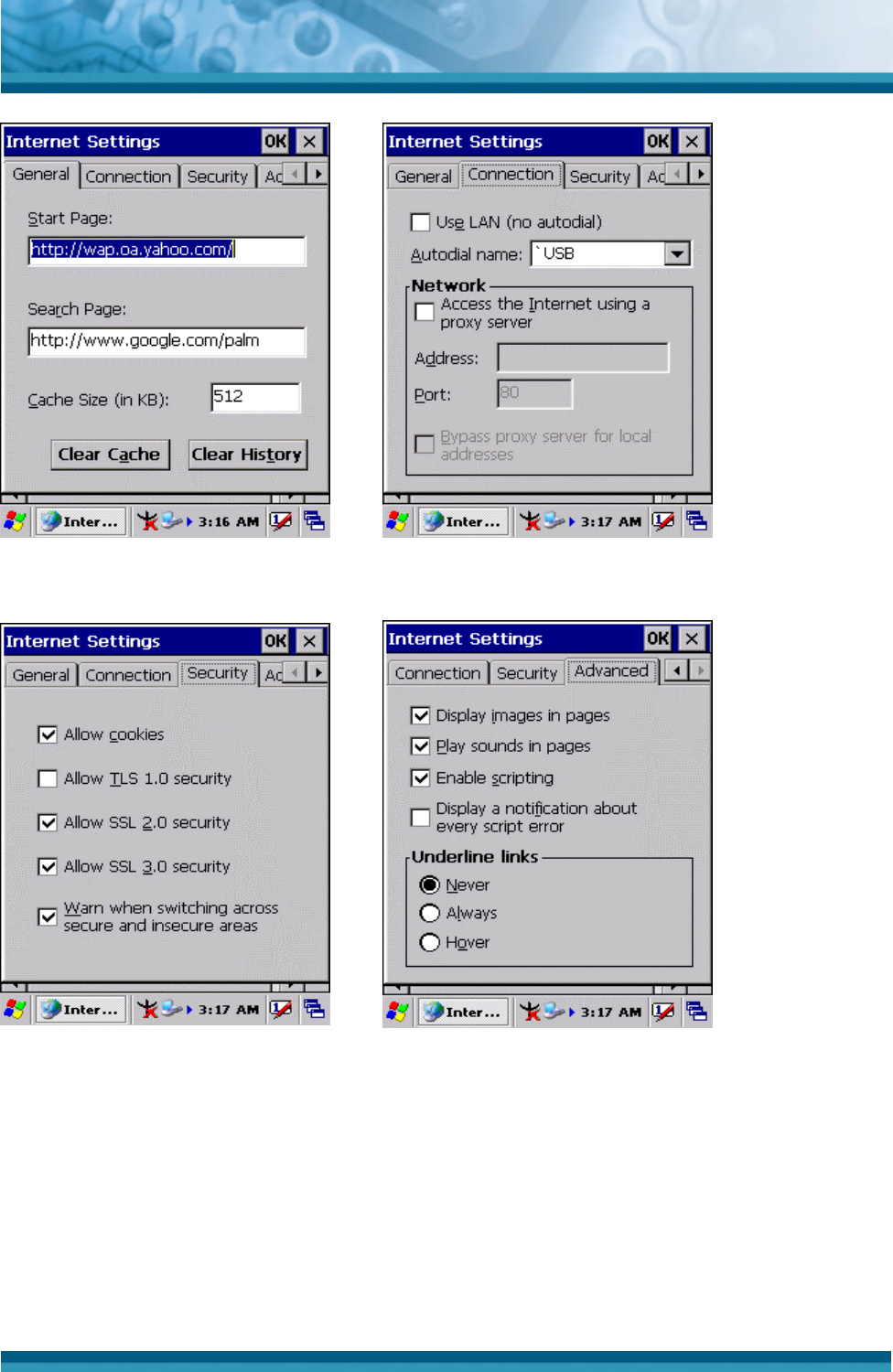
OPTICON
User's manual
PHL-7000 series
3
-
34
Figure 3-55 Internet Settings Figure 3-56 Internet Settings
Figure 3-57 Internet Settings Figure 3-58 Internet Settings
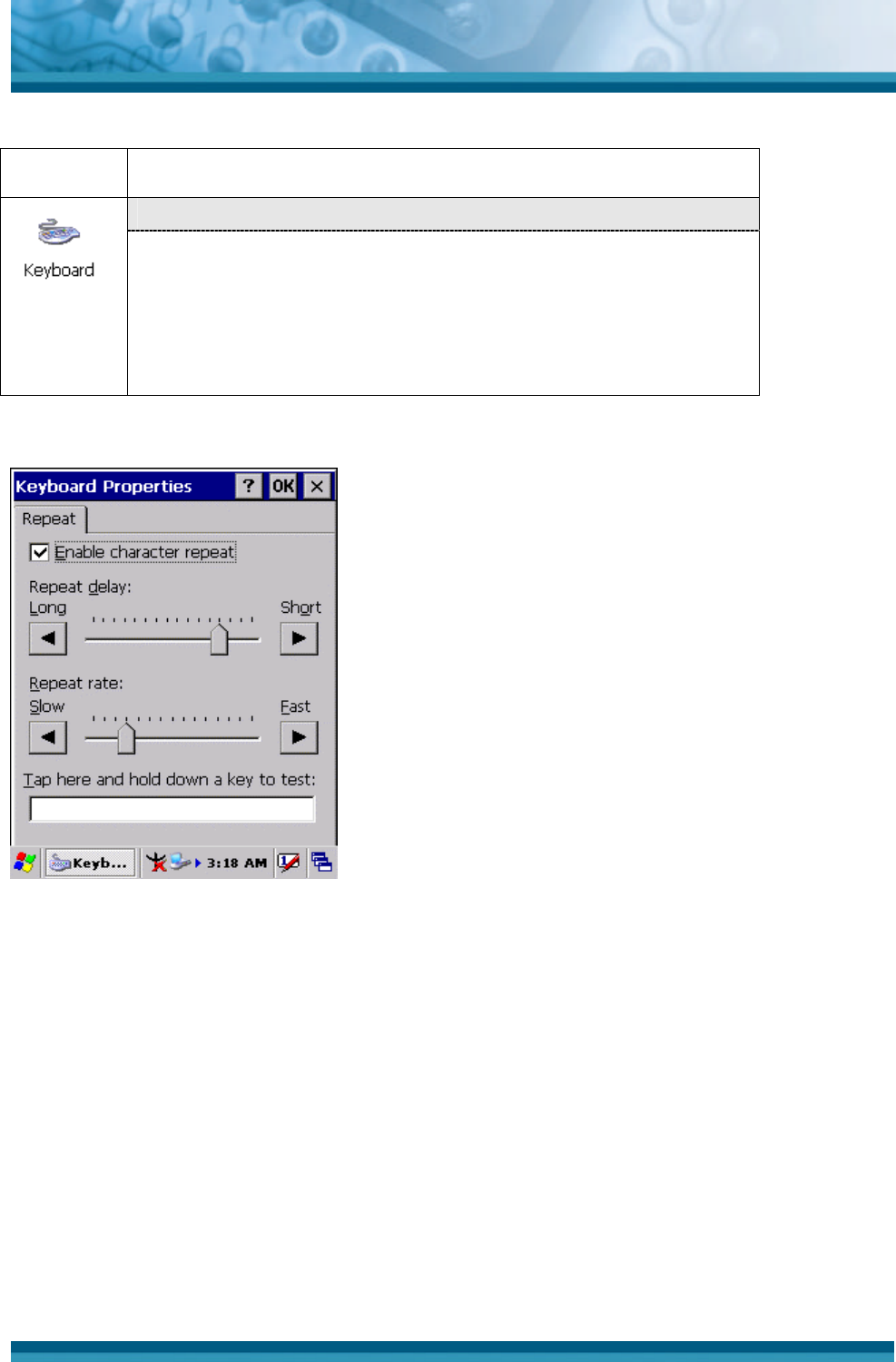
OPTICON
User's manual
PHL-7000 series
3
-
35
3.2.10 Keyboard
ICON ITEM & FUNCTION
• “Repeat” Tab :( Figure 3-59)
ü To change the amount of time between depressions before
repetition starts, adjust the Repeat delay slider
ü To change the repeat rate, adjust the Repeat rate slider.
ü Test your new setting.
ü Tap “ OK” to exit the “Keyboard” Tab.
Table 3-30 Keyboard
Figure 3-59 Keyboard Properties

OPTICON
User's manual
PHL-7000 series
3
-
36
3.2.11 Network and Dial-up Connections
ICON ITEM & FUNCTION
• “Connection” Tab :
ü To create a “Dial-up Connection”:
Ø Double-tap the “Make New connection”.
Ø In the “Make New Connection” dialog box, enter a name
for the connection.
Ø Select “Dial-Up Connection”.
Ø Select the “Next” button.
Ø Select the modem you want use.
Ø Select “Configure”
Ø Under “Connection Reference”, use the default settings
provided. If you can’t connect using these settings, see
your ISP or network administrator for specific
information. If you want to always enter a phone number
before connecting, Select “Manual Dial”. Select “OK”.
Ø Select “TCP/IP Settings”. In the “General” tab, ensure
“Use Server-assigned IP address” is selected. In the
“Name Servers” tab, ensure “Use Server-assigned
addresses” is selected, and select “OK”. If you are
unable to connect with these default settings, see your
ISP or network administrator for specific TCP/IP
information.
Ø Select the “Next” button and type the telephone number.
Ø Select the “Finish” button.
The connection you just created appears as an icon in the
“Network and Dial-up Connections” folder.
ü Set up a point-to-Point Protocol(PPP) account with an
ISP and obtain the following information:
Ø Access telephone number
Ø User name
Ø Password
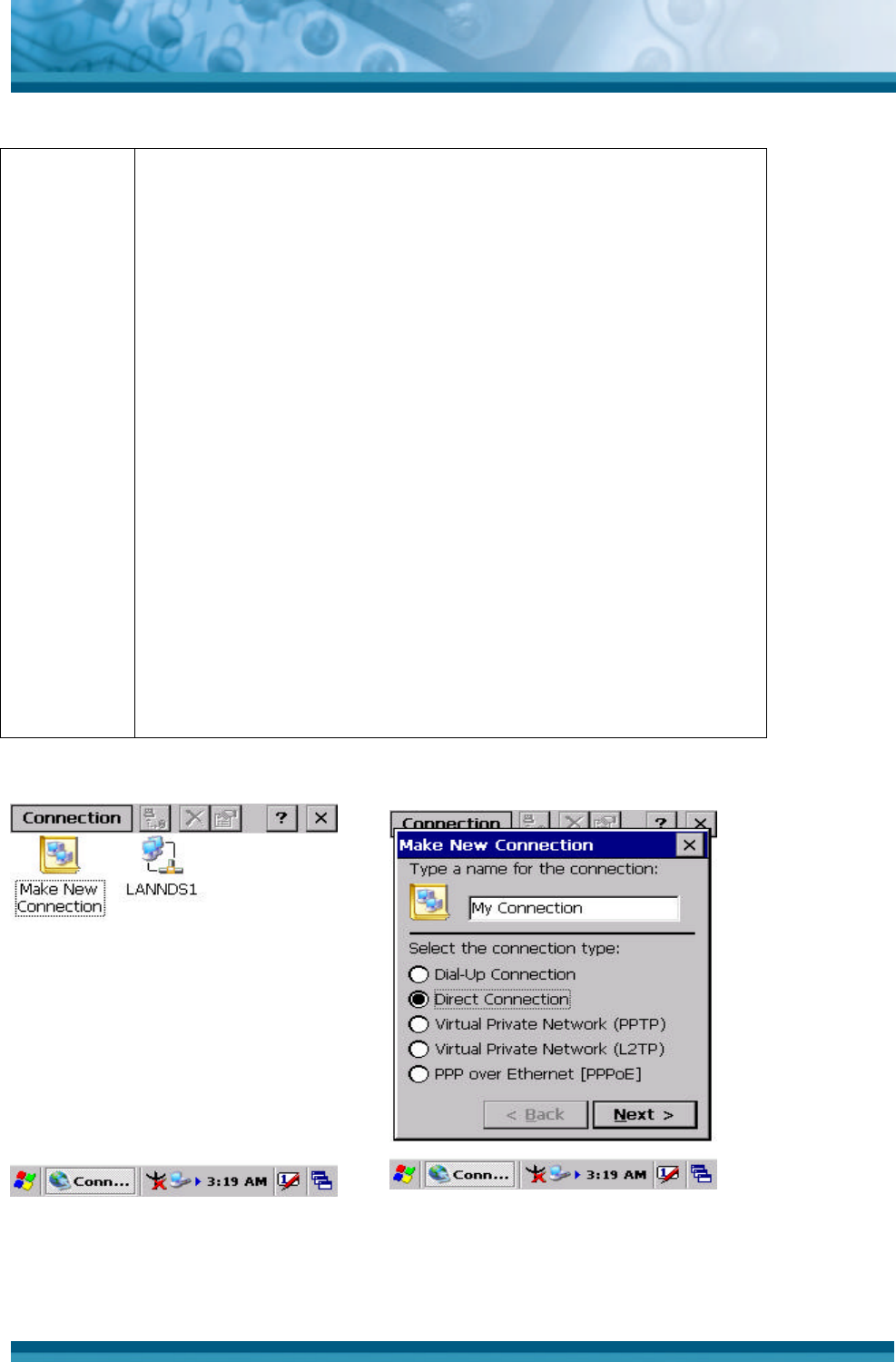
OPTICON
User's manual
PHL-7000 series
3
-
37
Once you have established an account, create a new
connection on your device. When creating this connection, you
should be able to use all of the default TCP/IP settings provided
in the Make New Connection Wizard. If you can’t connect using
the default settings, contact your ISP or access your ISP’s Web
site for specific TCP/IP information as well as primary and
secondary DNS address.
ü Modify connection setting
Ø Select Start > Settings > Network and Dialup
Connections
Ø Select the icon for connection settings you want to
modify.
Ø Select File > Properties, or double- tap the appropriate
icon.
Ø Select desired options. There may be additional settings
that depend on the connection. To modify, select the icon
and select the icon and select Advanced Settings…
from the menu.
Table 3-31 Network and Dial-up Connections
Figure 3-60 Network and Dial-up
Connections
Figure 3-61 Network and Dial-up
Connections
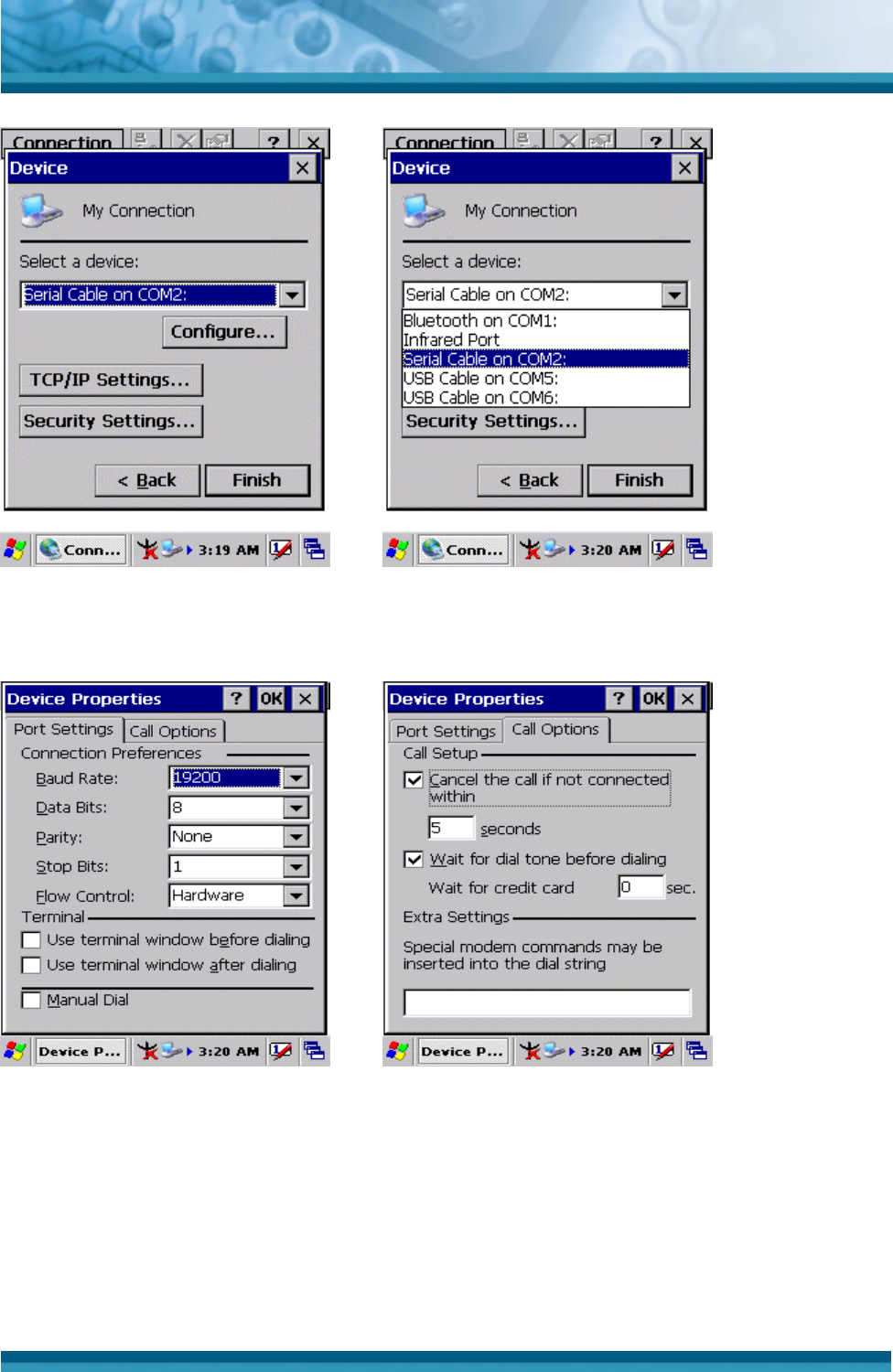
OPTICON
User's manual
PHL-7000 series
3
-
38
Figure 3-62 Network and Dial-up
Connections
Figure 3-63 Network and Dial-up
Connections
Figure 3-64 Network and Dial-up
Connections
Figure 3-65 Network and Dial-up
Connections
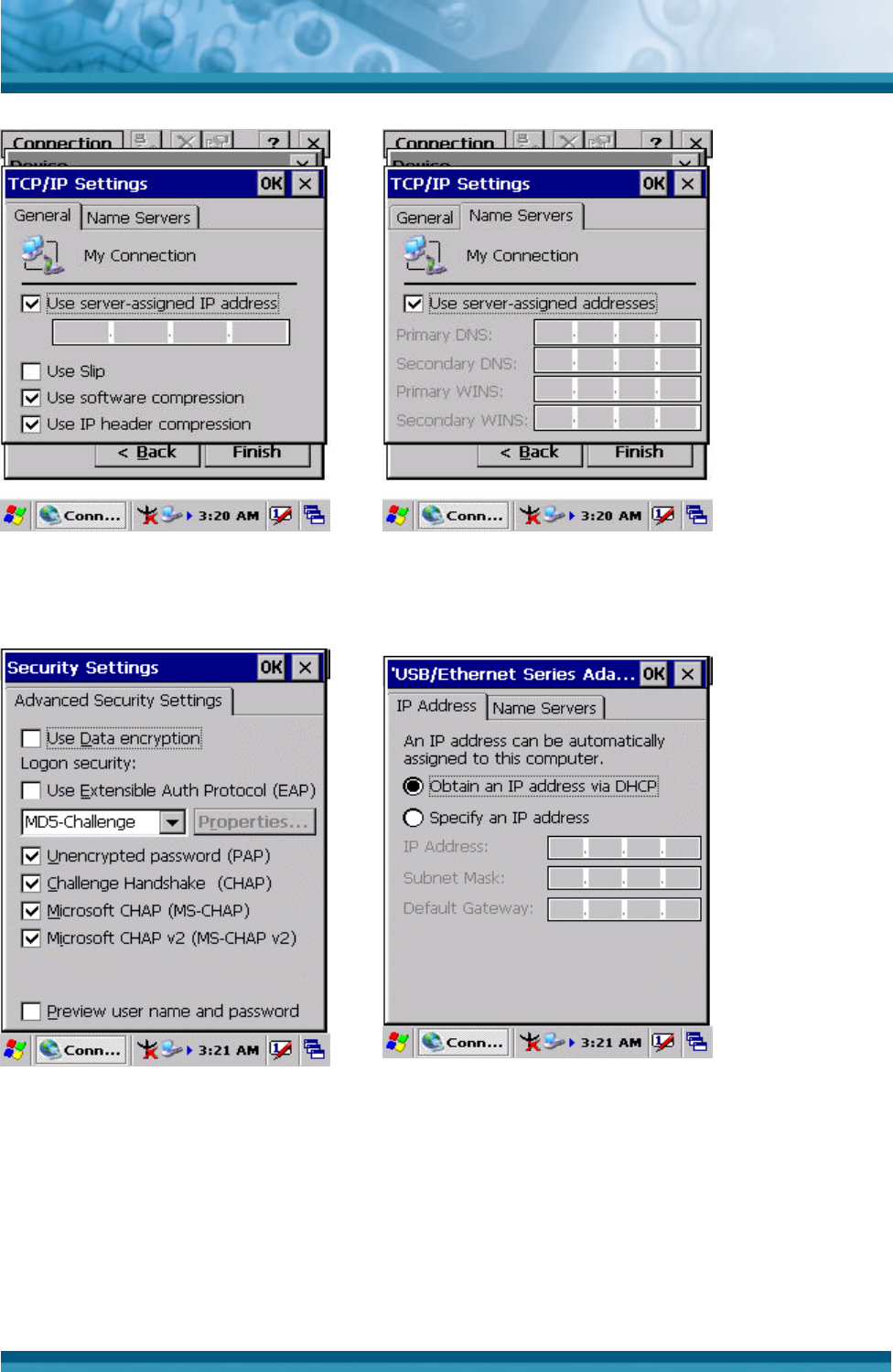
OPTICON
User's manual
PHL-7000 series
3
-
39
Figure 3-66 Network and Dial-up
Connections
Figure 3-67 Network and Dial-up
Connections
Figure 3-68 Network and Dial-up
Connections
Figure 3-69 Network and Dial-up
Connections